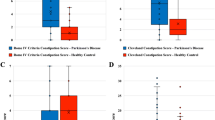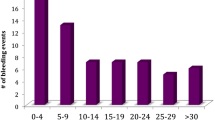Abstract
Purpose
Familial dysautonomia (FD) is a rare hereditary sensory and autonomic neuropathy (HSAN-3) that is clinically characterized by impaired pain and temperature perception and abnormal autonomic function. Patients with FD have gastrointestinal dysmotility and report a range of gastrointestinal symptoms that have yet to be systematically evaluated. The aim of this study was to establish the frequency and severity of gastrointestinal symptoms in patients with FD.
Methods
The validated National Institutes of Health Patient-Reported Outcomes Measurement Information System (PROMIS) survey questionnaire, together with additional FD-specific questions, were distributed to 202 living patients with genetically confirmed FD who had been identified from the New York University FD Patient Registry or, when relevant, to their respective caretaker. As a comparison group, we used a general US adult population for whom PROMIS scores were available (N = 71,812).
Results
Of the 202 questionnaires distributed, 77 (38%) were returned, of which 53% were completed by the patient. Median age of the respondents was 25 years, and 44% were male. Gastrostomy tube was the sole nutrition route for 25% of the patients, while 53% were reliant on the gastrostomy tube only for liquid intake. The prevalence of gastrointestinal symptoms was significantly higher in each of the eight domains of PROMIS in patients with FD than in the controls. Gastrointestinal symptoms as measured by raw scores on the PROMIS scale were significantly less severe in the FD patient group than in the control population in all domains with the exception of the abdominal pain domain. The surveys completed by caregivers reported the same burden of symptoms as those completed only by patients.
Conclusion
Gastrointestinal symptoms affect nearly all patients with FD. Gastrointestinal symptoms are more prevalent in adult patients with FD than in the average US adult population but are less severe in the former.




Similar content being viewed by others
References
Almario CV, Ballal ML, Chey WD, Nordstrom C, Khanna D, Spiegel BMR (2018) Burden of gastrointestinal symptoms in the united states: results of a nationally representative survey of over 71,000 Americans. Am J Gastroenterol 113:1701–1710
Ariel I, Wells TR (1985) Structural abnormalities of the myenteric (Auerbach's) plexus in familial dysautonomia (Riley–Day syndrome) as demonstrated by flat-mount preparation of the esophagus and stomach. Pediatr Pathol 4:89–98
Axelrod FB (2004) Familial dysautonomia. Muscle Nerve 29:352–363
Axelrod FB, Schneider KM, Ament ME, Kutin ND, Fonkalsrud EW (1982) Gastroesophageal fundoplication and gastrostomy in familial dysautonomia. Ann Surg 195:253–258
Bland JM, Altman DG (1995) Multiple significance tests: the Bonferroni method. BMJ 310:170
Brown WJ, Beauchemin JA, Linde LM (1964) A neuropathological study of familial dysautonomia (Riley-Day syndrome) in siblings. J Neurol Neurosurg Psychiatry 27:131–139
Craig AD, Craig A (2009) How do you feel–now? The anterior insula and human awareness. Nat Rev Neurosci 10:1
George L, Chaverra M, Wolfe L, Thorne J, Close-Davis M, Eibs A, Riojas V, Grindeland A, Orr M, Carlson GA, Lefcort F (2013) Familial dysautonomia model reveals Ikbkap deletion causes apoptosis of Pax3+ progenitors and peripheral neurons. Proc Natl Acad Sci USA 110:18698–18703
Harris PA, Taylor R, Minor BL, Elliott V, Fernandez M, O'Neal L, McLeod L, Delacqua G, Delacqua F, Kirby J, Duda SN, Consortium RE (2019) The REDCap consortium: building an international community of software platform partners. J Biomed Inform 95:103208. https://doi.org/10.1016/j.jbi.2019.103208
Kochar B, Martin CF, Kappelman MD, Spiegel BM, Chen W, Sandler RS, Long MD (2018) Evaluation of gastrointestinal patient reported outcomes measurement information system (GI-PROMIS) symptom scales in subjects with inflammatory bowel diseases. Am J Gastroenterol 113:72–79
Krausz Y, Maayan C, Faber J, Marciano R, Mogle P, Wynchank S (1994) Scintigraphic evaluation of esophageal transit and gastric emptying in familial dysautonomia. Eur J Radiol 18:52–56
Linde LM, Westover JL (1962) Esophageal and gastric abnormalities in dysautonomia. Pediatrics 29:303–306
Lumley T, Diehr P, Emerson S, Chen L (2002) The importance of the normality assumption in large public health data sets. Annu Rev Public Health 23:151–169
Margulies SI, Brunt PW, Donner MW, Silbiger ML (1968) Familial dysautonomia. A cineradiographic study of the swallowing mechanism. Radiology 90:107–112
Mora CF, Norcliffe-Kaufmann L, Palma J-A, Kaufmann H (2015) Chewing-induced hypertension in afferent baroreflex failure: a sympathetic response? Exp Physiol 100:1269
Nasreddine ZS, Phillips NA, Bedirian V, Charbonneau S, Whitehead V, Collin I, Cummings JL, Chertkow H (2005) The Montreal Cognitive Assessment, MoCA: a brief screening tool for mild cognitive impairment. J Am Geriatr Soc 53:695–699
Norcliffe-Kaufmann L, Axelrod F, Kaufmann H (2010) Afferent baroreflex failure in familial dysautonomia. Neurology 75:1904–1911
Norcliffe-Kaufmann L, Slaugenhaupt SA, Kaufmann H (2017) Familial dysautonomia: History, genotype, phenotype and translational research. Prog Neurobiol 152:131–148
Palma JA, Spalink C, Barnes EP, Norcliffe-Kaufmann L, Kaufmann H (2018) Neurogenic dysphagia with undigested macaroni and megaesophagus in familial dysautonomia. Clin Auton Res 28:125–126
Pearson J, Pytel BA, Grover-Johnson N, Axelrod F, Dancis J (1978) Quantitative studies of dorsal root ganglia and neuropathologic observations on spinal cords in familial dysautonomia. J Neurol Sci 35:77–92
Ramprasad C, Spalink C, Vanegas I, Norcliffe-Kaufmann L, Palma JA, Levy J, Kaufmann H, Chen LA (2018) Gastrointestinal bleeding is common in children with familial dysautonomia: a case-control study (1980–2017): presidential poster award: 1054. Am J Gastroenterol 113:S603
Riley CM, Day RL et al (1949) Central autonomic dysfunction with defective lacrimation; report of five cases. Pediatrics 3:468–478
Slaugenhaupt SA, Blumenfeld A, Gill SP, Leyne M, Mull J, Cuajungco MP, Liebert CB, Chadwick B, Idelson M, Reznik L, Robbins C, Makalowska I, Brownstein M, Krappmann D, Scheidereit C, Maayan C, Axelrod FB, Gusella JF (2001) Tissue-specific expression of a splicing mutation in the IKBKAP gene causes familial dysautonomia. Am J Hum Genet 68:598–605
Spiegel BM, Hays RD, Bolus R, Melmed GY, Chang L, Whitman C, Khanna PP, Paz SH, Hays T, Reise S, Khanna D (2014) Development of the NIH Patient-Reported Outcomes Measurement Information System (PROMIS) gastrointestinal symptom scales. Am J Gastroenterol 109:1804–1814
Strigo IA, Craig AD (2016) Interoception, homeostatic emotions and sympathovagal balance. Philos Trans R Soc Lond B Biol Sci 371:20160010
Acknowledgements
We thank Chris Almario for providing data for our reference study population.
Funding
This research was supported by National Institute of Neurological Disorders and Stroke (NINDS) grant U54NS065736 and the Familial Dysautonomia Foundation.
Author information
Authors and Affiliations
Corresponding author
Ethics declarations
Conflicts of interest
J.-A. Palma has received fees as consultant or advisory board member for Lundbeck, Takeda, Biogen, Dr. Reddy’s, and PTC; is the principal investigator in clinical studies sponsored by Theravance, Biohaven, and Biogen; receives research support from the National Institutes of Health, the Food and Drug Administration, the Familial Dysautonomia Foundation, Inc., the MSA Coalition, and the Michael J. Fox Foundation; and is managing editor of Clinical Autonomic Research. L. Norcliffe-Kaufmann has received fees as consultant or advisory board member for PTC and Theravance; receives research support from the National Institutes of Health, the Food and Drug Administration, the Familial Dysautonomia Foundation, and the Michael J. Fox Foundation. H. Kaufmann serves on a scientific advisory board for Lundbeck, Biogen, Theravance, Biohaven, and PTC; receives research support from the National Institutes of Health, the Food and Drug Administration, the Familial Dysautonomia Foundation, Inc., the MSA Coalition, and the Michael J. Fox Foundation; and serves as Editor-in-Chief of Clinical Autonomic Research. A. Khan is a consultant for Medtronic. All other authors have no conflicts of interest to report.
Ethical approval
Patient consent was obtained following local Institutional Review Board (IRB) guidelines for recruiting research study participants when their capacity to given written informed consent was questionable. The study protocol was approved by the NYU School of Medicine IRB which received a copy of all questions. The study was conducted according to the guidelines laid down by the Helsinki Declaration of 1964, and its later amendments.
Rights and permissions
About this article
Cite this article
Ramprasad, C., Norcliffe-Kaufmann, L., Palma, JA. et al. Frequency and burden of gastrointestinal symptoms in familial dysautonomia. Clin Auton Res 31, 109–116 (2021). https://doi.org/10.1007/s10286-020-00735-9
Received:
Accepted:
Published:
Issue Date:
DOI: https://doi.org/10.1007/s10286-020-00735-9




